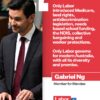
Coalition Splits: Has Alliance Lost Its Way?
I remember seeing footage , several years ago, of a jubilant Malcolm Turnbull, then prime minister and Liberal leader, speaking in Tamworth to loyal members of the National Party. These were the rank and file who had spent weeks stumping for their man in New England, Nationals leader and deputy prime minister Barnaby Joyce, who had resubmitted himself to voters after discovering he was a dual citizen of Australia and New Zealand.
A lot was riding on the outcome. Turnbull’s government had the slimmest possible majority in the lower house, and the loss of the Nationals leader would have been bad for the government as well as morale. Consequently, Turnbull was overjoyed when he thanked voters in New England “for getting the band back together”. Joyce’s handsome victory was, he explained, a “great demonstration” of the “strength of our Coalition”.
While it may seem unfair to bands everywhere to lean too heavily on that metaphor, there is something to it. Like The Beatles, the Liberal and National parties have allowed their creative tension to become little more than just tension. Like Simon and Garfunkel, deep-seated resentments have been allowed to fester without resolution for too long. And now, like Fleetwood Mac, the two parties have chosen to go their own way, at least for a time.
The Coalition is first and foremost an agreement – or rather, a series of agreements. It is predicated on the pragmatic reality that neither the Liberal Party (and beforehand, its predecessor parties) nor the agrarian National (formerly Country) Party was able to govern alone, or at least not for very long.
The first of these agreements was struck in February 1923, following an election the previous year that left the Nationalist Party, led by wartime prime minister Billy Hughes, well short of a lower house majority. The new Country Party won 14 seats in the lower house (roughly 18%) on its own, making it a force to be reckoned with.
Country MPs were willing to form a power-sharing agreement with the Nationalists, but not without cost. The larger party had to jettison its leader in favour of a new prime minister, Stanley Melbourne Bruce . The rural party won a hefty share of the ministries (five out of 11) and Earle Page, Country Party leader, became treasurer and de facto deputy prime minister.
Though they were not aware of it, Bruce and Page were creating something that has since become a tradition , an idea that can all too easily seem like an immutable part of Australia’s political life.
For more than 100 years now, some form of that “Coalition” has stood against Labor, and in doing so has helped to constitute a two-party system whose predominance is well and truly waning.
The termination of the Coalition in 2025 is neither shocking nor unprecedented. Indeed, if the band analogy has any meaning here, it is because there have been so many discordant notes over those 102 years.
When the United Australia Party (UAP) came on to the federal scene in response to the Great Depression, the party of farmers chose to go it alone. The UAP won a majority and governed in its own right from 1931 to 1934, only joining the Country Party in coalition when the 1934 elections robbed it of outright majority.
The death of UAP founder and prime minister Joe Lyons in April 1939 tore that marriage apart. His successor, Robert Menzies, declared his desire to choose all ministers (even those from the Country Party) himself, thereby alienating that party. Apart from a few dissidents, the Country Party quit the coalition, until the outbreak of war and declining electoral fortunes made a remarriage necessary.
The Liberals and Country Party/Nationals managed their affairs well enough during their long stints in office from 1949 to 1972, and again under Malcolm Fraser (1975-83) and John Howard (1996-2007). But even in good times, these were not always the happiest of bandmates.
Country Party leader John McEwen dominated the government in the late 1960s, to the point of brazenly vetoing the leadership candidacy of Harold Holt’s deputy (the unpopular Billy McMahon) when the former went swimming and failed to return.
Fraser was often criticised by Liberal colleagues for his instinctive closeness to the National Party. Paul Davey explains that in Howard’s day, the Nationals felt “overshadowed” and “undersold”. In fact, the very word “Coalition” bordered on synonymous with “Liberal”.
To be fair, Howard had learned a lot about managing the Coalition relationship by the time he arrived at The Lodge. The agreement had been brutally severed during his first stint as leader, thanks to Queensland premier Joh Bjelke-Petersen’s quest to become prime minister.
A figure head of New Right populism, Bjelke-Petersen felt that neither the federal Liberal Party (then led by Howard) nor his National Party colleagues were made of tough enough stuff to beat modern Labor.
The Nationals’ federal leader, Ian Sinclair, later said the vision of Howard, Sinclair and Bjelke-Petersen presenting separate election programs was an “absolute farce”.
It mattered that the death of the Coalition was spearheaded by a state premier. Such agreements had always been less popular and more controversial within the state branches of both parties.
South of the Murray, it was quite unspectacular for Country Party MPs in the mid-20th century to change their allegiances and even stand alone in office with the tentative support of the Labor Party.
In Queensland, the Liberal and National Parties governed together, often with the latter as the senior partner. But Bjelke-Petersen scrapped the Coalition in that state in 1983 and consolidated its parliamentary majority at an election in 1986. By the time of his departure in 1987, both parties had badly fractured.
In time, the two parties merged in that state to prevent such outbreaks in future. Federal members of the Queensland LNP face some awkward conversations now.
In announcing the latest split , Nationals leader David Littleproud said his party was taking a “principled stance”, though what exact principles were involved we have not learned. His deputy, Kevin Hogan, said he hoped the parties would “get back together” later on.
We know the sticking points were these: a guaranteed $20 billion Regional Australia Fund, divestiture powers to break up businesses with unhealthy market power, obligations for better regional mobile coverage, and an ongoing commitment to the nuclear energy project.
The latter commitment flies in the face of electoral reason, but the other three policies are clearly informed by the history of telecommunications deregulation and privatisation (which caused many sleepless nights in the National Party during the Howard years) and the ever-present threat of other, more populist parties chasing Nationals MPs’ heels in regional Australia.
The National Party made a big effort to resist that pressure in the 1990s, when One Nation looked like it might decimate its grip on the regions. A few days ago, Pauline Hanson said the Nationals and One Nation could in fact form their own coalition, so close were their policy offerings. That this was even uttered is a testament to how much the Nationals have changed over the past 30 years in their quest for survival.
Time apart could provide the parties with the political space they need for self-reflection and strategic reorientation. But they will not have one another to blame for their performance in coming months and years. Breaking up the band is easy to do. Touring alone is hard.
Joshua Black is a Postdoctoral Research Fellow at The Australia Institute.


